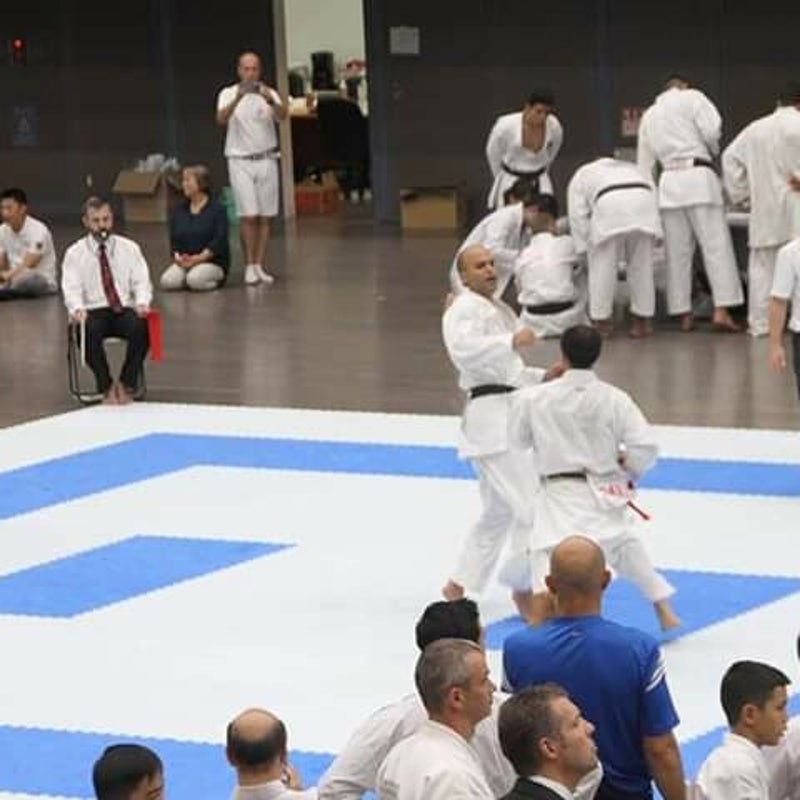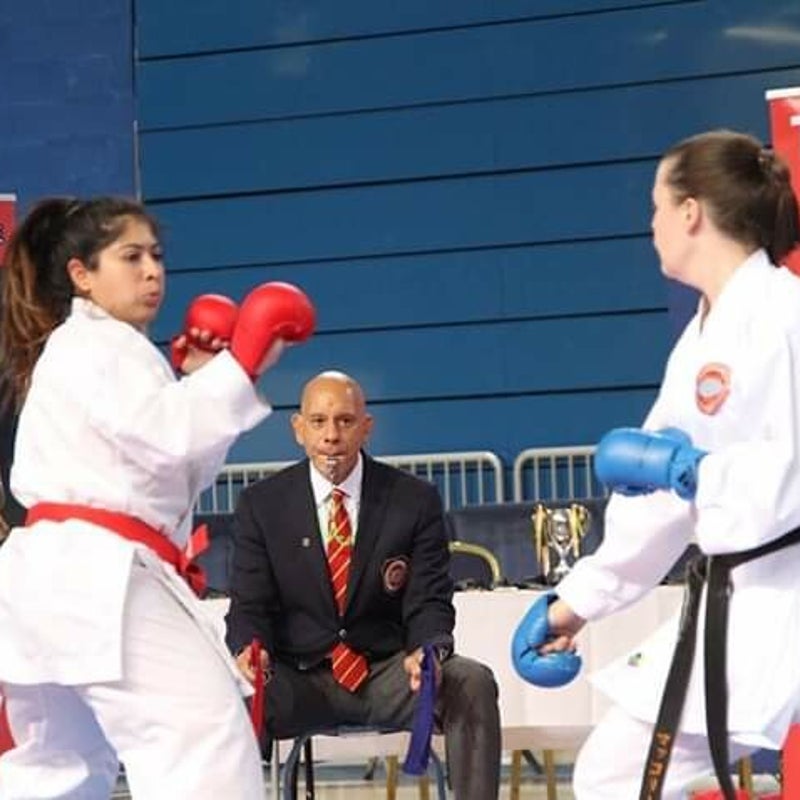KUMITE


Kumite - Traditional and Sports
Kumite is one of three symbiotic areas of Karate training, with Kihon and Kata the other two. All are intrinsic training methods in Karate.
Through Kihon and in Kata, one learns basic techniques and in Kumite one applies these with a sparring partner.
The word Kumite, when translated, can mean, "grappling hands", Sparring or Fighting. Kumite is a system where two practitioners train and demonstrate, against each other, defensive and offensive techniques learned, practised and developed during KIHON and KATA.
In traditional Shotokan Karate the different types of Kumite practised include; ippon-kumite (one step sparring); sanbon-kumite (three step sparring) or jiyu kumite (free sparring) all being performed as with a self-defence mindset. Etiquette principles apply to Kumite where the practitioner must apply proper technique, demonstrate correct power and speed, and, above all, exercise control.
TYPE
- Gohon kumite - five-step sparring, pre-arranged attack and counter exercises
- Sanbon kumite - three-step sparring, typically used to develop speed, strength, and technique.
- Ippon kumite - one step sparring, typically used for self-defence drills
- Jiyu ippon kumite - one step semi-free sparrin
- Kiso kumite - structured sparring drawn from a kata
- Jiyu kumite - free sparring
More experienced Black Belt students are allowed to participate at higher levels of Kumite wearing appropriate protective equipment.
Learning Outcomes & Goals
Kihon is the key to Kata and Kumite, the foundation builder to correct technique in Kumite and in Kata. Without these prerequisite elements, Kumite will be a variant outside of karate precepts. Kumite practice with foundations in practice of Kihon, with its focus on kata, is an essential means directly related to purposeful Kumite practice in the Dojo and in competition . Skills considered as essential elements for Kumite execution, has its foundations and origins in Kihon and Kata.
Sense Distance
- How far can I go forward or back
- How far does my technique go, or that of the partner
- From where do I have to start
- At what distance does the technique have an effect
Sensing the Target
- What is the objective and why
- Where do I meet the partner exactly
- Which body parts do I use
Controlling Impact
- How does it feel to make contact, or get hit
- How can I reduce/increase my effectiveness
Co-ordinate the Movement
- How do I use my legs, hips, torso and shoulders
- What is the right timing for the movement
Focus on Opponent/Partner & their Technique
- Concentration on the "goal"
- What is the correct timing for the defence
- Implementation of technique
- Movement in space
Discipline
- Hardening physically and psychologically
- Managing the fear of being hit
- Development of assertiveness
Self-control
- Avoiding anger and aggression
Inner calm
- Attain serenity in demanding situations
Kumite Topics
Ma
MA means the space between two contestants or the time between two actions.
There is the MA between techniques in Kata, while in Kumite it can be the distance between the opponents.
Breathing
The body performance much depends on the oxygen level in blood.
The ability to deliver an efficient attack, block, deviation, or counter is influenced by how breathing is done. Take advantage when the opponent breathes out; time to attack, breathing in; the time when the power and concentration are diverted.
Taisabaki
The technique applied to avoid the opponent's attack. The aim of the technique is to be able to position at an angle enabling delivery of a counter attack.
Defence
The defence system has a wide spectrum. It can be executed by using a body shift, for e.g Taizabaki, with the leg; e.g lifting the knee or using Mikazuki Geri as an attack deviation or even blocking a potential Nagewaza. In terms of arms, the key point is the elbow, it should be the axis and its motions should be as small as possible.
Attack
The attack is also a system. All power can be generated with the body weapons and be devastating or controlled. The mindset here is to think about how to generate speed, power, timing, breathing, contraction, expansion and awareness stage (zanchin) all in one; When is it appropriate to be applied, e.g, gono-sen, sen-no-sen, sense-no-sen; The way to apply it, blocking and attacking at the same time, applying a defensive technique as an attack, Feint and Drawing.
Feint
Is an action to cause in the opponent a break down in concentration enabling opportunity to create a potential attack. If the feint is not fully committed then the attack could fail, being exposed to a counterattack.
Drawing
It is the action of opening yourself to your opponent's attack by dropping or lifting your guard, waiting for the attack, and then countering. Empi Kata has a clear example of drawing and, the first WSKF-SEDAI grading under Heian Shodan Application has this drill
Archetypes
An inherent characteristic of a fighter. Archetype is understood as a specific style a person is going to adopt in a combative situation, much depending on the psychological capacity and DNA. Some persons may develop fast twitch muscle fibres while another's slow. In other words, the fight style is based on its own genetic.
Go-no-sen
After the attack, block/evade and counterattack.
'Sen' means 'initiative' or 'ahead'.
The purpose of Initiative (Sen) is to gain advantage over your opponent.
Applying Go-no-sen tactic does not always mean that the counterattack has to be performed after the opponent attack. It means that you can also control the adversary's timing and even dictate the attack options having an absolute fight control.
Se-no-sen
Intercepting the attack with simultaneous block/evade and counterattack.
It is important to understand and know before hand factors of when, how and where an attack can happen. Key point: Read the attacker intention and react as soon as they deliver their attack.
Sense-no-sen
Attack immediately when you become aware that attack is going to be commitment.
This stadium of awareness is also zanshin's stage, reading your adversary’s intention to attack; you take the initiative, immediately launching an attack or move away.
Kumite Tutorial "Go-no-sen"
Kumite Tutorial "Sen-no-sen"
Kumite Tutorial "Ashi Sabaki"
Kumite Tutorial "Geri"
| Sessions | Monday | Wednesday | Friday | Saturday |
|---|---|---|---|---|
| Karate Advance | 7 pm OnSite | 7 pm OnLine | 6 pm OnLine | 11 am OnSite |




































